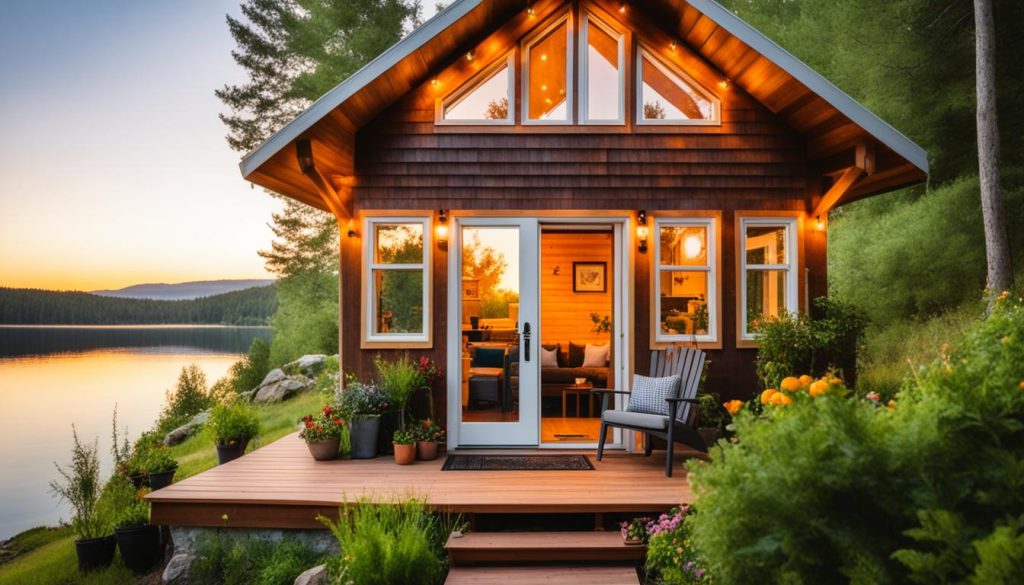Did you know that tiny homes, a growing trend in housing, face legal obstacles in many areas?
According to various sources, tiny homes may be considered illegal in some places due to zoning laws, building codes, and regulations that do not specifically accommodate these unique dwellings. The scale of this issue is significant, impacting those who dream of downsizing and living a simpler, more sustainable lifestyle.
However, it’s important to note that the legality of tiny homes varies depending on the municipality and province. Understanding the specific rules and regulations in your area is crucial to ensure the legality of your tiny home.
Let’s delve into the legal issues surrounding tiny homes and explore how they can navigate the complex world of regulations.
Key Takeaways:
- Many areas have regulations and codes that make tiny homes illegal due to zoning and building restrictions.
- The legality of tiny homes varies depending on the municipality and province.
- Understanding and complying with the specific rules and regulations in your area is crucial for the legality of your tiny home.
- Tiny homes offer a way to downsize and live a simpler, more sustainable lifestyle.
- Consulting with local authorities and working with certified builders can help ensure compliance with all regulations.
Are Tiny Homes Legal in Ontario?
When it comes to tiny homes in Ontario, you may be wondering about their legality. Good news! Tiny homes are indeed legal in Ontario, provided they meet certain requirements and regulations. Let’s delve into the specifics.
First and foremost, in order for a tiny home to be considered legal in Ontario, it must have a total square footage of over 188 square feet. This ensures that the home provides sufficient living space.
Additionally, the tiny home must have a designated living and sleeping area, complete with a bathroom that includes a bath or shower. A cooking area with running water is also required to meet the necessary standards.
Furthermore, it is crucial that tiny homes in Ontario comply with the Ontario Building Code standards. These standards ensure that the construction and safety aspects of the home are up to par.
Lastly, obtaining a building permit from the municipality is essential for legalizing your tiny home in Ontario. The permit process may vary depending on the specific municipality, so it’s important to do thorough research and reach out to the appropriate authorities to ensure compliance.
It’s worth noting that some municipalities may have additional rules and restrictions beyond these basic requirements. Furthermore, there may be different regulations in place for tiny homes on wheels compared to those without wheels.
To illustrate the requirements visually, here’s a table summarizing the key aspects:
| Requirement | Description |
|---|---|
| Total Square Footage | Must be over 188 square feet |
| Living/Sleeping Area | Must have a designated living and sleeping area |
| Bathroom | Must include a bath or shower |
| Cooking Area | Must have running water |
| Ontario Building Code | Must comply with the building code standards |
| Building Permit | Must obtain a permit from the municipality |
By adhering to these requirements and regulations, you can ensure the legality of your tiny home in Ontario and enjoy the benefits of this alternative housing option.
Where Can You Put a Tiny Home in Ontario?
There are several options for placing a tiny home in Ontario. Whether you own an empty lot or want to utilize your own backyard, there are opportunities to create your dream tiny home. However, it is important to navigate the regulations and requirements to ensure compliance and legality.
If you have an empty lot that you own, placing a tiny home on it can be a viable option. However, it is crucial to ensure that your tiny home complies with all building code requirements and municipal bylaws. This will help you avoid any legal issues and ensure a smooth process.
Another option is placing a tiny home in your own backyard. While this offers convenience and proximity to your main residence, it still requires a permit and careful compliance with building codes and bylaws. Consulting with your local municipality can provide valuable information and guidance in this regard.
Tiny house communities are also available in various locations throughout Ontario. These communities provide a sense of community and a supportive network of like-minded individuals. By joining a tiny house community, you can enjoy the benefits of shared resources and a strong sense of belonging.
If you are in the process of building your main house, you can live in a tiny home on your construction site for up to 2 years. This temporary arrangement allows you to save on accommodation costs and oversee the progress of your main house while enjoying the comfort of a cozy tiny home.
In some municipalities, additional living spaces on cabin land are permitted. This can be a great option for those who seek a remote, nature-oriented lifestyle. However, it is crucial to consult with local authorities to understand the specific regulations and requirements for these locations.
| Placing Options | Requirements |
|---|---|
| Empty Lot | Compliance with building code requirements and municipal bylaws |
| Backyard | Permit and compliance with building codes and bylaws |
| Tiny House Communities | Application and acceptance into the community |
| Construction Site | Temporary living arrangement for up to 2 years |
| Cabin Land | Compliance with local regulations for additional living spaces |
Can You Live in a Tiny Home Year-Round in Ontario?
Living in a tiny home year-round is possible in Ontario as long as you adhere to the necessary regulations and requirements. In order to ensure the legality of your tiny home, it must meet all building codes and bylaws set forth by the province and municipality.
The minimum square footage requirement for a tiny home in Ontario is 188 square feet. Additionally, if your tiny home is located in an urban or suburban area, it must be connected to municipal services such as electricity and water. This ensures that you have the necessary amenities for year-round living.
By following the regulations and guidelines, you can enjoy the comfort and convenience of living in a tiny home in Ontario throughout the year. It offers a unique and sustainable way of living, allowing you to fully experience the benefits of a minimalist lifestyle.
Living in a tiny home year-round provides a sense of freedom, simplicity, and sustainability. It allows you to embrace a smaller carbon footprint and reduce your impact on the environment. With careful planning and adherence to tiny home regulations in Ontario, you can enjoy the comfort and charm of tiny home living, no matter the season.
Why Do People Love Tiny Homes?
Tiny homes have captured the hearts of many individuals for a myriad of reasons. These compact dwellings offer a range of advantages and foster a unique way of life that appeals to people seeking simplicity, affordability, and environmental sustainability.
- Affordability: One of the primary reasons people love tiny homes is their affordability. Constructing and maintaining a tiny home typically costs significantly less than a traditional house. With a smaller footprint and fewer materials required, tiny homes offer a more budget-friendly housing option.
- Sustainable Living: Tiny homes have a smaller environmental footprint compared to larger houses. These compact spaces require less energy for heating and cooling, reducing their overall impact on the environment. Additionally, the use of sustainable materials and energy-efficient appliances further enhances their eco-friendliness.
- Minimalistic Lifestyle: The minimalist lifestyle associated with tiny homes is another reason why people are drawn to them. Living in a tiny home encourages individuals to declutter and simplify their possessions, focusing on what truly matters. This streamlined way of life promotes mindfulness and a sense of freedom from materialistic desires.
- Freedom and Mobility: Tiny homes on wheels provide the option of mobility, allowing individuals to take their homes on adventures and explore different locations. This sense of freedom and flexibility appeals to those seeking a nomadic lifestyle or those who want the ability to change their surroundings without leaving their home behind.
These are just a few of the reasons why people love tiny homes. From the financial benefits to the sustainable living practices and the desire for a simpler lifestyle, the advantages of tiny homes continue to resonate with individuals looking to embrace a cozy, minimalist, and environmentally conscious way of life.

How to Have a Tiny Legal Home in Ontario?
Building a legal tiny home in Ontario requires careful adherence to specific rules and guidelines set by the municipality. To ensure compliance and the smooth process of obtaining permits, it is advisable to work with certified tiny home builders. These professionals have the expertise and knowledge to navigate the legal requirements and ensure that your tiny home meets all the necessary regulations.
It is essential to be fully aware of the bylaws and regulations specific to your area before embarking on your tiny home project. By understanding the legal requirements, you can proactively design and build a tiny home that meets all necessary standards. Compliance with these regulations will not only ensure the legality of your tiny home but also contribute to your overall safety and well-being.
Whether you plan to build your tiny home on vacant land, in your backyard, or within a tiny house community, thorough knowledge of the legal requirements is crucial. Working with professionals who are well-versed in the building codes specific to Ontario will alleviate any potential issues and help you navigate the intricate process of building a legal tiny home.

Benefits of Working with Certified Tiny Home Builders
- Expertise in Ontario building codes: Certified builders have an in-depth understanding of the Ontario Building Code standards and can ensure your tiny home is built to meet these requirements.
- Permit acquisition: They can handle the details of obtaining the necessary permits, saving you time and potential headaches.
- Compliance with regulations: Certified builders are well-versed in the local bylaws and regulations, ensuring your tiny home adheres to all legal requirements.
- Quality craftsmanship: Working with certified builders ensures that your tiny home is constructed with the highest level of quality and craftsmanship.
- Peace of mind: By entrusting your project to certified builders, you can have peace of mind knowing that your tiny home is being built legally and professionally.
| Steps to Building a Legal Tiny Home in Ontario |
|---|
| 1. Research and familiarize yourself with the building codes and bylaws specific to your municipality. |
| 2. Consult with certified tiny home builders to discuss your project and understand the requirements and costs involved. |
| 3. Work with the builders to design a tiny home that meets all legal requirements, taking into account factors such as square footage, layout, and necessary amenities. |
| 4. Secure the necessary building permits from your municipality before starting construction. |
| 5. Engage the services of certified professionals, such as electricians and plumbers, to ensure that all aspects of your tiny home meet the required standards. |
| 6. Regularly communicate with your builders and municipality throughout the construction process to ensure compliance and address any concerns that may arise. |
| 7. Upon completion, schedule a final inspection with the municipality to obtain the necessary approvals and certifications for your tiny home. |
What’s the Draw of Tiny Homes?
The appeal of tiny homes lies in their affordability, simplicity, and eco-friendliness. These compact living spaces are often more affordable to build and maintain compared to traditional homes, making them an attractive option for individuals looking to reduce their housing costs.
Furthermore, tiny homes promote a simpler way of life with less clutter. The limited space encourages individuals to prioritize what truly matters to them, leading to a more intentional and minimalist lifestyle. This focus on essentials can bring a sense of freedom and peace of mind.
Another key advantage of tiny homes is their smaller environmental footprint. These homes use fewer resources, require less energy for heating and cooling, and produce fewer greenhouse gas emissions. For individuals concerned about their impact on the environment, living in a tiny home can be a sustainable choice.
In conclusion, the benefits of tiny homes stem from their affordability, simplicity, and eco-friendliness. They offer a chance to downsize, simplify, and reduce the financial and environmental impact of conventional housing. By embracing the tiny living movement, individuals can achieve a more affordable, intentional, and environmentally-conscious lifestyle.

Leave a Reply
You must be logged in to post a comment.